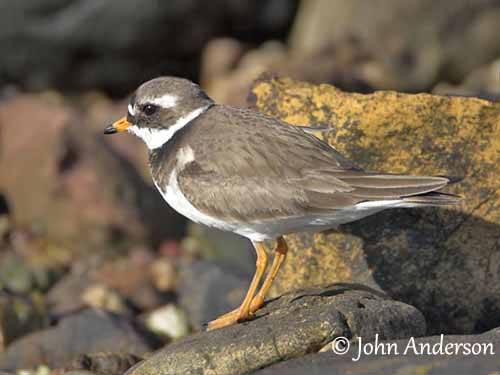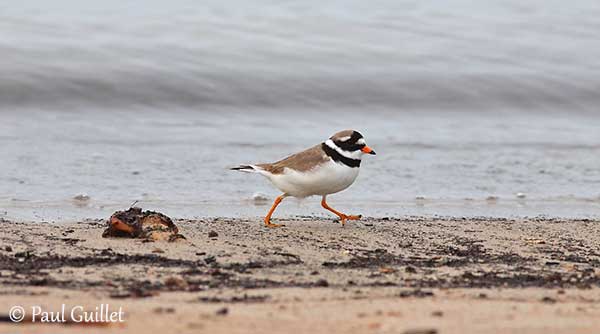
Fr: Pluvier grand-gravelot
Ang: Common Ringed Plover
All: Sandregenpfeifer
Esp: Chorlitejo Grande
Ita: Corriere grosso
Nd: Bontbekplevier
Sd: Större strandpipare
Photographers:
John Anderson
John Anderson Photo Galleries
Steve Garvie
RAINBIRDER Photo galleries & Flickr Rainbirder
Paul Guillet
Photos d’Oiseaux
Otto Plantema
Trips around the world
Ingo Waschkies
Bird Photography
Text by Nicole Bouglouan
Sources:
HANDBOOK OF THE BIRDS OF THE WORLD Vol 3 by Josep del Hoyo-Andrew Elliott-Jordi Sargatal - Lynx Edicions - ISBN : 8487334202
SHOREBIRDS by Peter Hayman, John Marchant and Tony Prater – Christopher Helm – 1986 – ISBN: 0747014035
THE COMPLETE BOOK OF BRITISH BIRDS – Written by “Royal Society for the Protection of Birds” experts - Préface de Magnus Magnusson - Michael Cady- Rob Hume Editors - ISBN: 0749509112
GUIDE DES LIMICOLES de D. Taylor - Delachaux et Niestlé - ISBN : 2603014080
ENCYCLOPEDIE DES OISEAUX DE FRANCE ET D’EUROPE – de Peter Hayman et Rob Hume - Flammarion – ISBN : 2082009920
THE HANDBOOK OF BIRD IDENTIFICATION FOR EUROPE AND THE WESTERN PALEARCTIC by Mark Beaman, Steve Madge - C.Helm - ISBN: 0713639601
Biodiversity Explorer – The Web of Life in Southern Africa
What Bird-The ultimate Bird Guide (Mitchell Waite)
Pájaros de España (JL Beamonte)
Common Ringed Plover
Charadrius hiaticula
Charadriiformes Order – Charadriidae Family
INTRODUCTION:
The Common Ringed Plover is included in the subfamily Charadriinae, more diverse than other subfamilies in the family Charadriidae. It is very similar to the Semipalmated Plover from North America, and it is its counterpart for Europe and Asia.
The bold facials pattern of many Charadriidae species is important during the displays, both courtship and territorial interactions. In aggressive behaviour, the males stand face to face, that enhances the black-and-white facial markings, making them well-visible for rival or threatening opponent.
The Common Ringed Plover is a common Palearctic species. It also breeds in NE Canada and Greenland. This migratory plover winters in Africa, Caspian Sea and SW Asia, according to the subspecies.

REPRODUCTION OF THIS SPECIES:
Biometrics:
Length: 18-20 cm
Wingspan: 48-57 cm
Weight: 42-78 g
The adult male of nominate race shows conspicuous black-and-white markings. The upperparts including crown, mantle to uppertail-coverts, scapulars, wing-coverts and tertials are pale brown, whereas sides of rump and outer rectrices are white. The greater coverts have white tips, and rest of wing-coverts shows narrow whitish fringes in fresh plumage.
A conspicuous white wingbar is formed by the white shafts and webs of the blackish primaries and secondaries. The tail has brown base and blackish subterminal bar. Most rectrices are white-tipped but the central pair lacks the white tips. The outer pairs are all-white.
The underparts are white, except the conspicuous black breast band (sometimes brown-and-black), extending narrowly around the base of hindneck. The underwing is white. Chin and throat are white and join the white collar above the black breast band.
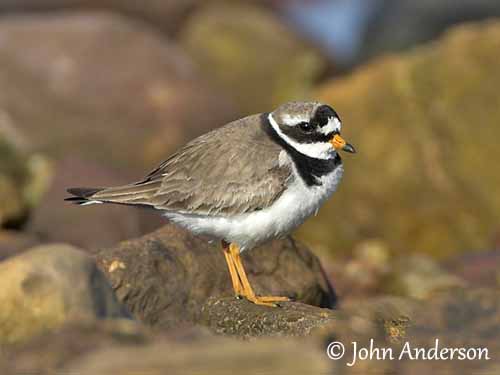
On the head, lores, ear-coverts, base of forehead and frontal bar are black. The forehead is widely white. We can see a white supercilium extending above and behind the eye.
The bill is orange-yellow with black tip (duller outside breeding season). The eyes are dark brown, surrounded by narrow, dull yellowish-orange eyering. Legs and feet are bright orange-yellow, but the feet lack the basal web between middle and outer toes. This feature is present in Semipalmated Plover.
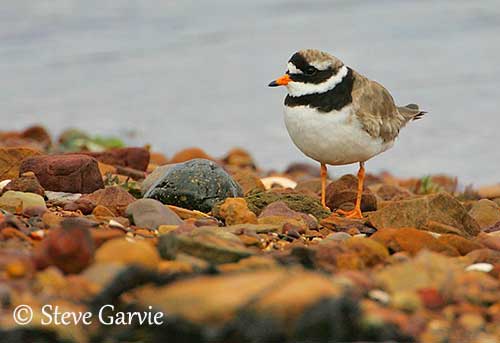
The female is slightly duller with mostly tinged brown breast band and ear-coverts.
The nominate race does not show distinct non-breeding plumage.
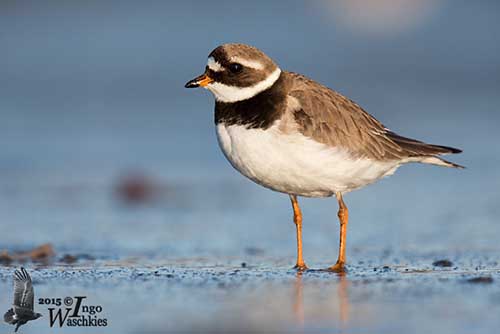
The juvenile is paler with buffy fringes. The head pattern is brownish and indistinct. The breast band is brownish and often broken on the frontal part.
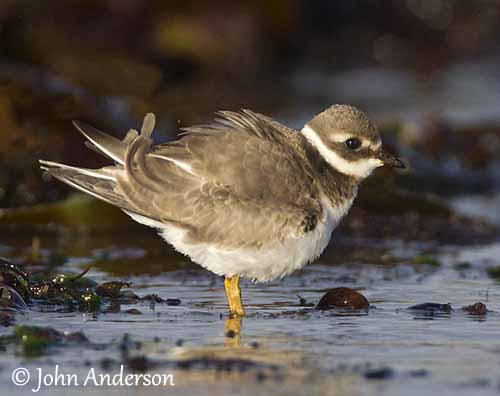
SUBSPECIES AND RANGE:
The Common Ringed Plover has three subspecies.
C.h. psammodromus occurs in NE Canada, through Greenland to Svalbard, Iceland and Faeroes. It winters from SW Europe to W Africa. It is very similar to nominate race.
C.h. hiaticula (described above) is found in S Scandinavia to British Islands and NW France. It winters from British Islands S to Africa.
C.h. tundrae occurs in N Scandinavia and N Russia, E to Chukotskiy Peninsula and N Bering Sea on St Lawrence Island (USA). It winters from Caspian Sea and SW Asia S to S Africa. This race is smaller and has darker, duller upperparts. The white supercilium behind the eye is usually narrower. Orange is less extensive on the bill. Outside breeding, the black areas are mostly olive-brown and the bill is duller.
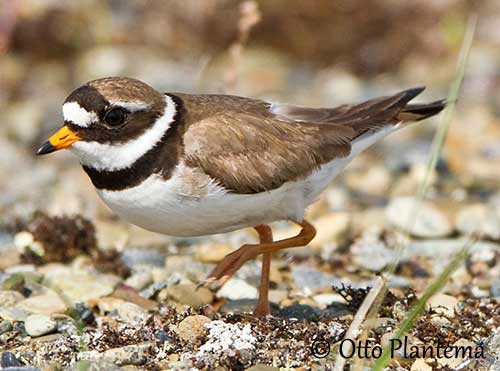
HABITAT:
The Common Ringed Plover breeds on shingle or sandy coastal beaches, sandbars, mudflats and in estuaries. It may also breed inland by rivers and lakes, on open tundra with low vegetation, occasionally in adjacent meadows and farmland.
Outside the breeding season, it frequents rocky coastlines, estuarine mudflats, saltpans and marshes.
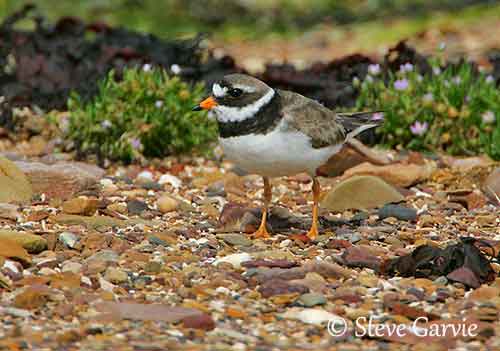
CALLS AND SONGS: SOUNDS BY XENO-CANTO
The Common Ringed Plover’s typical call is a mellow whistling “too-lee” rising in pitch and with emphasis on the second syllable. The alarm call is a longer and lower “too-weep”.
During the breeding season, the aerial display is accompanied by a repeated “tee-leea, tee-leea…” or “leea-leea…”
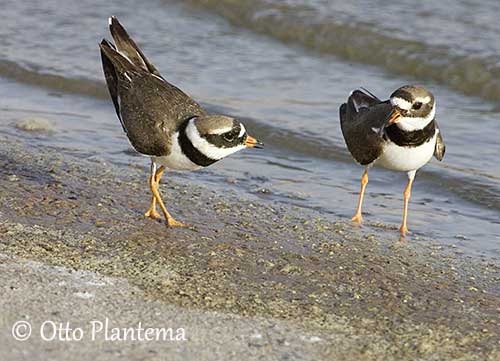
BEHAVIOUR IN THE WILD:
The Common Ringed Plover feeds on crustaceans, molluscs, aquatic worms, isopods, amphipods and various insects such as ants, beetles, flies and their larvae.
It forages on beaches, mudflats and shorelines. It uses foot-trembling in the water, but it taps on the ground with one foot, imitating the rainfall, in order to drive the preys to the surface.
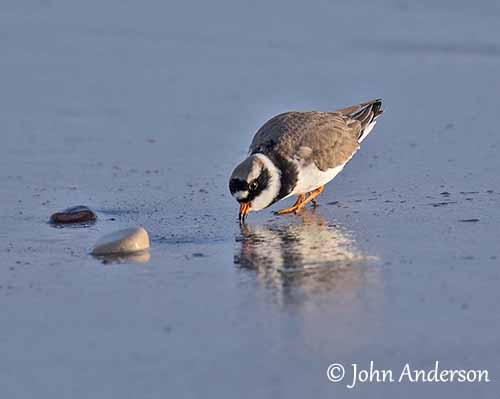
The Common Ringed Plover has strong eyesight that allows to locate the preys. The best feeding territories, usually intertidal flats, may be defended against other plovers. It forages by day and by night, typically in small groups of up to 50 birds, and occasionally in much larger flocks of 1200/1500 individuals.
They roost together close to their feeding areas, usually just above the high tide line.

During the breeding season, the Common Ringed Plover performs aerial displays including a slow-flapping flight around the territory, accompanied by song. They are seasonally monogamous, sometimes for longer periods.
During aggressive interactions, it attacks the intruders entering the territory. The bird leans forwards with semi-open wings to display the breast pattern. It also fans its tail while curving it towards the opponent.
The black-and-white plumage pattern is enhanced during these displays.

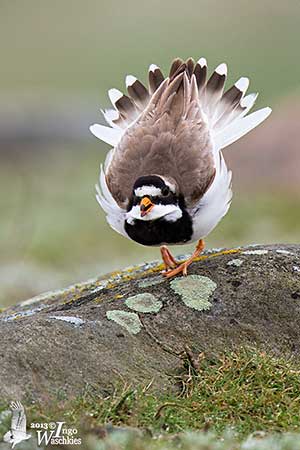
The Common Ringed Plover is migratory and the northernmost populations move S to winter in Africa or SW Asia. Some W European birds may remain in the vicinity of their breeding grounds. The Nearctic breeders migrate across N Atlantic in a single flight or through Iceland and Greenland, to winter in W Africa.
The race “tundrae” crosses Eurasian and African continents in broad front towards E and S Africa.
The return to the breeding grounds occurs between late March and May.
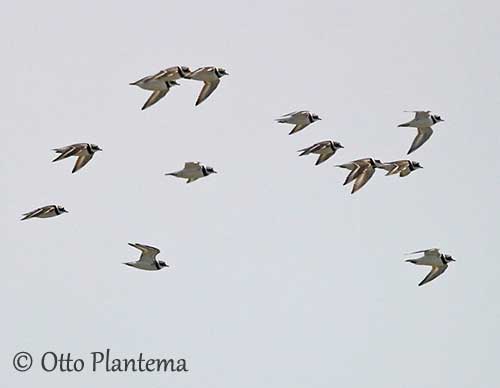
The Common Ringed Plover flies fast with steady wingbeats and short glides. It usually flies low over ground or water.
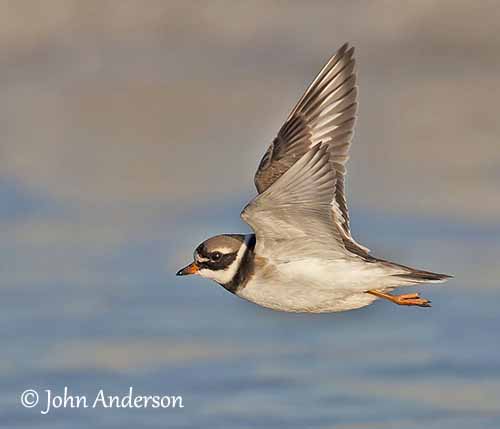
REPRODUCTION OF THIS SPECIES:
The laying occurs between April and July depending on the range.
The Common Ringed Plover may nest in loose groups or solitary. When nesting in groups, the nests are between 5 and 100 metres apart. There is a high degree of site fidelity. They usually breed with larger Charadriiformes for better protection.
The nest is a shallow scrape in the ground, lined with pebbles and vegetation. It is strongly defended by both adults by calling loudly and swooping at intruders.
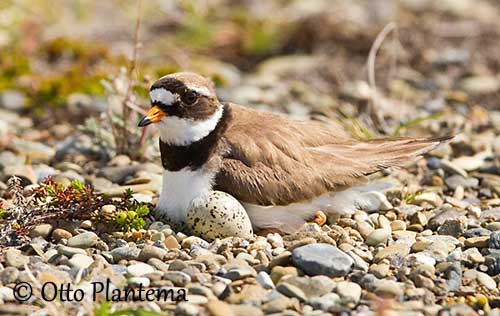
The female lays 3-4 buff eggs with brown and black spots. Both parents share the incubation during 23-25 days. At hatching, the chicks have pale buffy-grey down with dark upperparts including the crown, and white underparts with blackish, indistinct, broken breast band. They feed themselves under the protection of the adults, and they can fly about 24 days after hatching.
If the nest with eggs or chicks is threatened, the adult usually performs the “broken-wing” display, in order to drive the predator away from the nest-site.
PROTECTION / THREATS / STATUS:
The Common Ringed Plover is threatened by petroleum pollution on the Baltic Sea coastline during the stopovers. Drainage of wetlands and scrub overgrowth due to changing land management practices are another problem in this area.
The global population was estimated to number 360,000/1,300,000 individuals in 2006. The overall population trend is decreasing. However, numbers can fluctuate markedly. The wintering numbers in W Europe have increased since 1970’s.
But currently, the Common Ringed Plover is evaluated as Least Concern.
